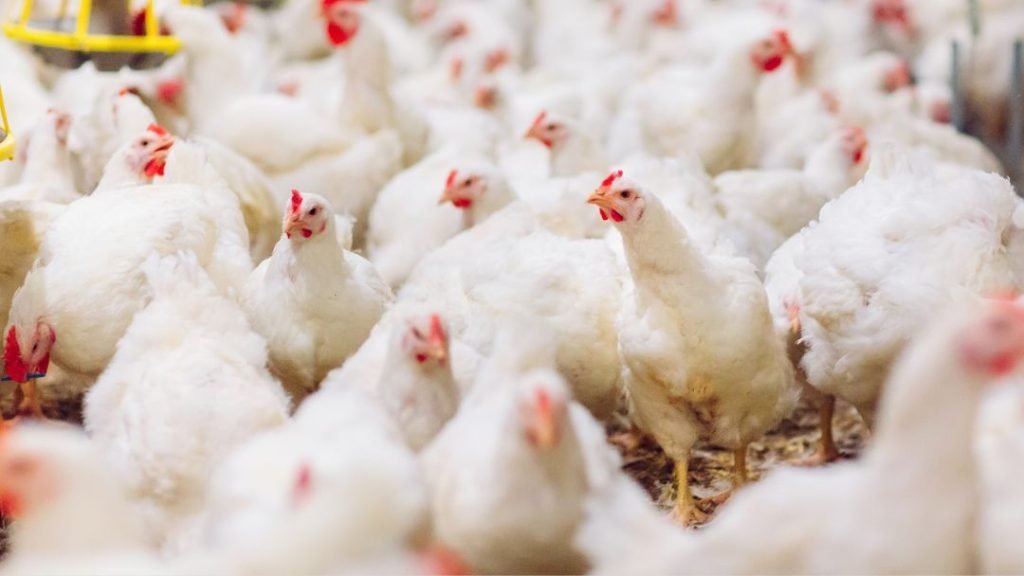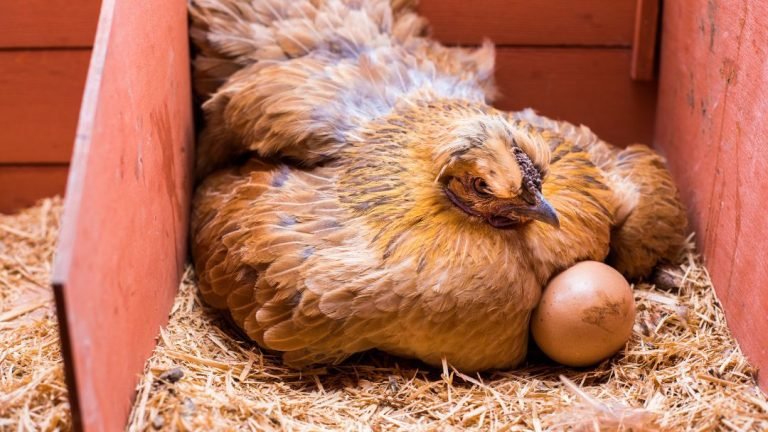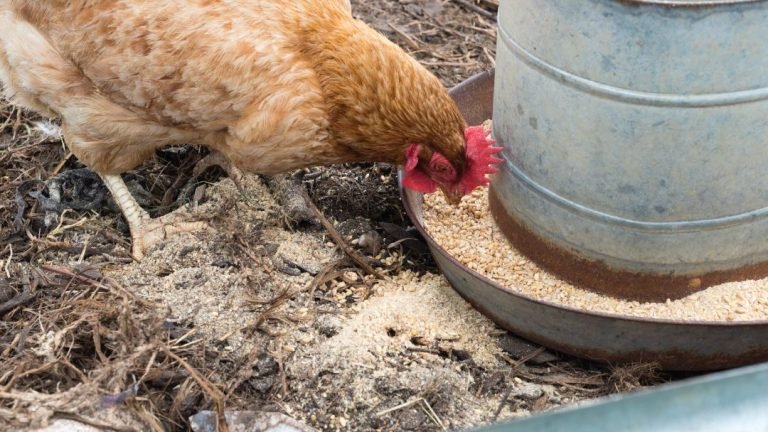Do your few chickens have swollen and distended bellies? Are they facing difficulty in breathing? It is often a common sign of chicken water belly or Ascites. The mortality rate for this disease can be as high as 50-70%.
What is chicken water belly? Chicken water belly is a condition where yellowish-colored, ascitic fluid accumulates in a chicken’s abdomen or peritoneal cavity. It can be caused by various factors such as heart or lung disease, poor diet, or genetic factors.
What Is Chicken Water Belly?
A water belly or Ascites in chicken represents a spectrum of physiological and metabolic changes in one or more peritoneal cavities from non-inflammatory fluid accumulation.
Their abdominal or peritoneal cavity centrally located in the mid-to-caudal coelom has this yellowish-colored, ascitic fluid.
One of the most common syndromes of this illness is pulmonary hypertension. It mainly occurs when the pressure level is too high in the blood vessels that go from the heart to the lungs.
Oxygen deficiency is likely to occur from Ascites in chickens. It will result in low blood oxygen levels as it causes the capillaries in the chicken’s lungs to expand.
If the water belly in chickens is not treated on time, it will cause extra pressure on its liver. The liver may become swollen and congested.

What Are The Common Causes Of Chicken Water Belly?
A water belly or Ascites in chicken generally doesn’t occur for a single reason. Sometimes, one disease leads to another.
Most of the time, several combined reasons are the culprits of this disease.
It is important to research and test properly to find the actual cause of this illness. Your flocks may have other diseases apart from this.
Environment
If your flocks live in high altitudes or lack a fresh air environment, it will cause increased arterial pressure.
Flocks are getting less oxygen at higher altitudes. High levels of airborne dust result in poor quality. It often leads to high ammonia levels.
Besides, imbalanced environmental temperature and humidity levels may result in this problem.
Are you raising too many chickens in a small coop? Remember, stock density can also cause water belly problems in chickens.
Nutrition
It is crucial to maintain a balanced nutrient density for chickens.
When it is too low or too high, it can lead to various diseases, including Ascites.
If you are growing baby chicks, changing and increasing the nutrient density over time is necessary.
Generally, there are two nutrient-density levels for chickens: high-density diets and low-density diets.
The ideal high-density diet is between 3,169 to 3,315 kcal/kg. On the contrary, low-density diets range from 2,876 and 3,023 kcal/kg.
Before choosing a particular plan, testing their digestibility and apparent metabolizable energy (AME) assays is crucial.
There are generally types of chicken feeds crumbles, pellets, and mash. Feed restriction might be necessary when your chickens already have any disease.
Hygiene
Maintaining good hygiene in a chicken coop is crucial to prevent the spread of infectious germs.
One of the most common reasons for Ascites in chicken is microorganisms.
Gram-negative bacteria cause various types of deadly infections, such as bloodstream infections.
For example, severe E. coli infection sometimes causes rapid death. Salmonella infection is another root cause of lack of hygiene.
Some natural foods served to chickens may have Campylobacter microbes due to improper handling and preparation. It often leads to bacterial gastroenteritis
Genetic Events
Different types of genes can cause Ascites in chickens.
One of the most common ones is the endothelial nitric oxide synthase (eNOS) gene, which is related to regulating blood pressure and blood flow.
Genes involved with regulating inflammation and oxidative stress may also cause this chicken water belly disease.
Marek’s Disease
A cell-associated herpes virus causes Marek’s Disease. It is also known as MD’ or ‘fowl paralysis.’
You will see a significant change in your flock’s nerves.
They will likely have tumors in some vital internal organs, the eyes, and the skin.
Most chickens don’t recover from this disease. Plus, it is highly contagious. The infection spreads quickly from bird to bird.
Respiratory Disease
A chicken may have different respiratory illnesses, such as laryngitis, bronchitis, tracheitis, pneumonia, etc.
There is a direct connection between a chicken’s respiratory system and lungs.
When the Respiratory system is not working properly, it will affect a chook lung. A partially damaged lung will affect the intake of oxygen.
Chickens may face difficulty in proper breathing. A lack of some specific minerals and vitamins can cause this disease.
Egg Binding Or Peritonitis
If a partially developed egg or yolk goes into the ovary of the chickens and is deposited within the body cavity, it is called egg binding or peritonitis.
The yolk is likely to cause an infection surrounding the intestines.
This problem mainly occurs due to the translocation of intestinal E. coli into the peritoneal cavity.
It may also occur when a bird matures too many egg follicles (yolks) at once.
Lethargy, too large hard abdomen, Reduced activity& appetite, Penguin-like stance, etc., are common symptoms of Egg binding or peritonitis
Obesity or Fatty liver
Does your chicken have obesity? Being overweight can cause hypertension or heart failure.
Serving too much food in each meal results in obesity and stress on the heart.
Excessive intake of dietary energy can cause fatty liver in chickens.
If the liver looks enlarged, pale, soft, and engorged with fat, it will likely have excess fat.
What Are The Symptoms Of Chicken Water Belly?
Chicken water belly can happen any time and you might even don’t have a clue. So you’ve to actively look for common symptoms and start the rescue procedure immediately.
01. Swollen Abdomen
Is your chicken’s abdomen swollen, hard/soft, and full of fluid?
Air swallowing (a nervous habit) development of fluid in the abdomen are the main causes of this problem. It is often called Abdominal swelling or enlargement.
However, it may also happen from overeating
02. Red Skin
Is the abdominal skin of the chicken red?
Sometimes, there might be an absence of feathers in their abdomen.
03. Limping
Due to the overstretched or torn muscles of chickens, they may limp and struggle to walk naturally.
In some cases, their legs might be slowly becoming paralyzed.
However, chickens may limp if they have any leg or foot injuries.
04. Struggle In Breathing
Is your chicken making gurgling, rattling, or congested (phlegmy) sounds while breathing?
When chooks face a severe oxygen deficiency, they struggle to breathe naturally.
They will stretch their necks coughing or panting.
05. Blue Or Purple Tint Wattles
A rosy, red color comb or wattles is the natural appearance of a chicken.
But if it looks like a blue or purple tint, it can be a sign of Ascites in chicken.
Generally, Ascites in chickens and poor blood circulation can cause this illness.
06. A Lack Of Energy And Appetite
Is your flock not eating as much as it used to?
A lack of appetite might be the common cause of this problem.
They will have reduced energy and stay calmly in an area for hours.
07. Poor Bird Development
A hen affected by Ascites may hatch poor-quality chickens.
Baby chicks will likely have meaty/thin, coarse, blocky, weak-looking heads and hard and shallow abdomens.
Plus, they may have a blank stare, crusted eyes, or always feel sleepy.
What Are The Treatments For Water Belly In Chickens?
The first important thing is figuring out the root cause of this illness. Take your birds to a certified chicken veterinarian and do a complete body check-up.
It is often curable if the disease occurs from genetics or feed restriction. But it should be in the first or earlier stage.
However, when other severe health issues or viruses cause this illness, you can’t treat them. After all, Ascites in chickens have a pretty high mortality rate.
Some veterinarians suggest feeding Brewer’s yeast, flax oil, and the herb eyebright to minimize the effect or incidence of Ascites in chicken.
Also, some experienced chicken keepers feed meals with oregano oil and vitamin C. Oils rich in n-3 fatty acids can be an effective choice against Ascites.
In some cases, it may work, but there is no guarantee.
In addition, some chicken owners drain the fluid from the belly. It is not a long-lasting solution, but it will provide temporary comfort for several weeks.
How to Prevent Water Belly in Chicken?
Due to the high mortality rate of Ascites in chickens, it is difficult to treat birds affected by this dangerous disease.
You have to take preventive actions to keep your chickens safe from water belly illness.
01. Ensuring Enough Oxygen Levels
Are you raising faster-growing chickens in an elevated location? One of the most common breeds is the Cornish Cross.
Avoid growing rapidly-growing breeds if your living location has a reduced oxygen level.
This type of chicken can’t cope with the environment.
They are likely to cause metabolic acidosis, leading to Ascites in chickens in the future.
You should either ensure sufficient oxygen or raise slow-growing chickens in your location.
02. Control Feed Intake
It is a good rule of thumb to ensure a balanced diet for your chickens.
Excessive eating is one of the root causes of obesity and fatty liver. Serve two pellet meals for your feathered friends daily.
A balanced diet should have Protein concentrates, cottonseed meal, grain legumes, etc.
You can also feed them fruits and vegetables, such as cooked beans, corn, non-sugary cereals, apples, etc., in a small amount daily.
The following table shows the ideal amount of chicken feed for various chickens.
| Life Stage | Bantam Breed | Heavy Breed |
|---|---|---|
| Chick (0-6 weeks) | 1/4 cup/day | 1/2 cup/day |
| Grower (6-20 weeks) | 1/2-3/4 cup/day | 1-1 1/2 cups/day |
| Layer (20+ weeks) | 1/4-1/2 cup/day | 1/2-3/4 cup/day |
| Broiler (0-8 weeks) | 1/2-1 cup/day | 1-2 cups/day |
| Broiler (8+ weeks) | 1 1/2-2 cups/day | 2-4 cups/day |
03. Keeping The Surrounding Environment Dry And Clean
A wet and dirty environment has a high chance of developing gram-negative bacteria.
Remember, this type of bacteria survives best in a moist environment.
A damp environment will give this bacteria to transmit quickly from one place to another and one chicken to another.
Keeping everything inside and outside the chicken coop in tip-top condition is a good practice to prevent the development of germs, bacteria, and viruses.
Do daily, weekly, monthly, and semi-annual cleaning carefully.
Also, use harm-free disinfecting products to ensure a healthy environment. Clean the chicken waterers and feeders regularly.
04. Ensuring Enough Ventilation
It is crucial to raise chickens in a well-ventilated space.
Otherwise, it will result in excessive heat, humidity, and moisture development on the walls and ceiling.
It is more likely to cause a major buildup of air pollution in the surrounding environment.
Make sure the chicken coop has vertical vents above your perch/roosts. It will ensure year-round natural ventilation.
You can also install adjustable flaps or sliding covers to ensure smooth airflow when needed.
It will also remove ammonia fumes created by the chicken manure from the chicken coop.
05. Using Flaked Chicken Bedding
Fine chicken bedding might be comfortable and cover a larger space.
But flaked chicken bedding is more appropriate for flocks to keep them safe from Ascites.
Flaked chicken bedding comprises larger wood shavings that provide more air circulation and absorbency.
This type of bedding is particularly good at trapping odors and is less likely to clump together, making it easier to clean.
Additionally, flaked bedding tends to be less dusty, which can be beneficial for chickens with respiratory issues.
Wrapping UP
Ensuring a healthy and safe environment for chickens to grow comfortably is essential. Ascites in chicken is not a contagious disease.
However, the bacteria or virus might be present in the surrounding environment, harming other chickens. Make sure to do a health check-up at least once every month.
Take care of your feathered friends properly to keep them safe from various vulnerable diseases. Now, you know what is chicken water belly and how to treat and prevent this illness.


